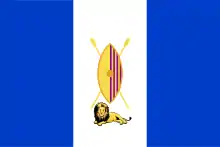Kato Kintu
Kato Kintu Kakulukuku[1] (fl. Late 13th century)[2] was the first kabaka (king) of the Kingdom of Buganda. "Kintu" is an adopted by-name, chosen for Kintu, the name of the first person on earth in Buganda mythology. Kato Kintu gave himself the name "Kintu" to associate himself with the "father of all people",[3][4][5][6][7][8] and he may have renamed his wife, from Nantuttululu to Nambi, because that was Kintu's wife's name.[9]
| Ssekabaka Kato Kintu | |
|---|---|
| Kabaka of Buganda | |
| Reign | late 13th century |
| Predecessor | None |
| Successor | Chwa I of Buganda |
| Born | Uganda |
| Died | Mid-14th century Nnono, Busujju |
| Burial | Nnono, Busujju |
| Spouse | Nambi Nantuttululu |
| Father | Kagona |
| Mother | Namukana |
Background and reign
Kintu was born at Bukasa Village, in the Ssese Islands, on Lake Nalubaale. He established his capital at Nnono, Busujju County. He fathered one child.
- Prince (Omulangira) Mulanga
The final days
Kabaka Kato Kintu[10] died at age thirty. He was buried at Nnono, Busujju County.
See also
References
- History of Buganda: From the Foundation of the Kingdom To 1900. CRC Press. 1972. pp. 35, 94, 95.
- Shaping the Society Christianity and Culiture: Special Reference to the African Culture of Buganda. Author House. 2012. p. 94.
- "The Founding of Buganda". Buganda.com. Retrieved 4 October 2014.
- The Kings of Buganda. East African Publishing House. 1971. p. 42.
- The historical tradition of Busoga, Mukama and Kintu. Clarendon Press. 1972. pp. 86, 87, 88.
- Chronology, Migration, and Drought in Interlacustrine Africa. Africana Pub. Co. 1978. p. 150.
- Afrique des Grands lacs. Zone Books. 2003. p. 113.
- Myth, Ritual, and Kingship in Buganda. Oxford University Press. 1991. p. 95.
- Kizza, Immaculate N. (2010). The Oral Tradition of the Baganda of Uganda: A Study and Anthology of Legends, Myths, Epigrams and Folktales. McFarland. pp. 22–23. ISBN 9780786456055.
- Dictionary of African Historical Biography, University of California Press, 1989, pp. 72, 109
External links
This article is issued from Wikipedia. The text is licensed under Creative Commons - Attribution - Sharealike. Additional terms may apply for the media files.

